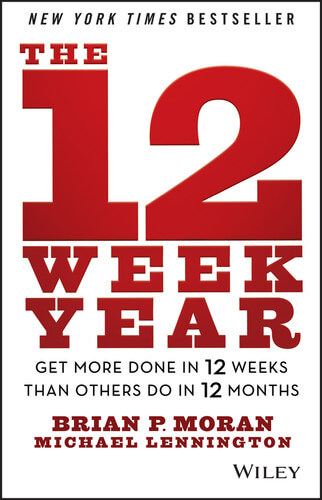12 Week Plan: Set Up Your Business for Success

Most business owners attempt to set yearly goals through a loose planning process or by making ambitious New Year’s resolutions. However, time and time again, this approach has proven to be ineffective. In business, annual goals tend to lose momentum, and without a clear, actionable plan, they quickly fall to the wayside. But what if I told you there’s a better, more efficient way to approach goal-setting?
Introducing the 12-Week Year Method — a strategy designed to help you achieve more in less time by focusing on short-term goals with a laser-like focus.
The Problem with Annual Planning
I frequently see business owners over-plan the next 12 months, setting lofty goals that often become irrelevant by mid-year. Sticking to a year-long plan can be incredibly challenging when the landscape of business is constantly shifting. When we try to plan beyond 90 days (12 weeks), we end up creating unnecessary work, because let’s face it — business is unpredictable. There are countless moments when you’ll need to pivot and adjust your course. That’s why the 12-Week Year makes so much sense. It gives your business the structure it needs while offering the flexibility to shift gears when necessary.

What is the 12-Week Year Method?
The 12-Week Year Method is a powerful planning system introduced by Brian Moran and Michael Lennington in their book The 12 Week Year. The concept stems from research showing that most business goals are achieved in the final quarter of the fiscal year when deadlines loom, and the pressure to deliver becomes intense. This end-of-year push is where productivity skyrockets.
So, why wait until Q4 to hit your stride? The 12-Week Year condenses the timeline, treating each 12 weeks as if it’s a full year. By doing so, you create urgency throughout the year, allowing you to accomplish more in a shorter period. Instead of waiting until the last minute to reach your goals, you’ll be taking action consistently, driving results in every quarter.
Since reading the book and adopting the 12-Week Year in my business, I’ve seen transformative results. My operations are more streamlined, I’m hitting my targets faster, and my focus has sharpened significantly.

How to Create Your 12-Week Year Plan
Ready to ditch the long-haul planning and get results faster? Here’s how you can build your own 12-Week Year Plan in five easy steps:
- Define Your Vision and Goals First, get crystal clear on your long-term vision. Where do you want your business to go? What goals will help you get there? These goals should be SMART — Specific, Measurable, Achievable, Relevant, and Time-bound. This framework ensures that your goals are not only ambitious but also practical within a 12-week timeframe.
- Break Down Your Goals into Milestones Once your vision and goals are set, it’s time to break them down into smaller milestones. By dividing your larger goals into actionable, bite-sized tasks, you’ll be able to make steady progress over the 12 weeks without feeling overwhelmed.
- Create an Action Plan Now that you’ve identified your milestones, build a detailed action plan. Outline the specific steps you need to take to hit each milestone, and assign deadlines to every task. This is where the power of the 12-Week Year really comes in — by focusing on only what’s necessary for the next 12 weeks, you can move faster and avoid distractions.
- Monitor Your Progress Stay accountable by tracking your progress regularly. Whether you prefer to use a project management tool like Asana or stick to a physical planner, it’s important to measure your results and adapt as needed. Every week counts in the 12-Week Year, so stay on top of your deadlines and keep a close eye on your wins and areas for improvement.
- Review and Adjust At the end of each 12-week cycle, it’s time to reflect. What worked well? Where did you fall short? Use this review period to adjust your next 12-Week Year Plan and continue refining your approach. The beauty of this method is that it keeps you agile, allowing you to pivot and improve with every cycle.

Why the 12-Week Year Works
The beauty of the 12-Week Year is its simplicity and focus. By concentrating on short-term goals, you create a heightened sense of urgency, which leads to greater productivity. It also encourages you to be more intentional with your time, focusing only on what will move the needle forward in your business.
Plus, because you’re reviewing and adjusting every 12 weeks, you have the flexibility to make necessary changes quickly rather than waiting an entire year to reassess. This means you’re always moving forward, always adapting, and always improving.
Why You Should Ditch Yearly Planning and Try the 12-Week Year Method
Most business owners attempt to set yearly goals through a loose planning process or by making ambitious New Year’s resolutions. However, time and time again, this approach has proven to be ineffective. In business, annual goals tend to lose momentum, and without a clear, actionable plan, they quickly fall to the wayside. But what if I told you there’s a better, more efficient way to approach goal-setting?
Introducing the 12-Week Year Method — a strategy designed to help you achieve more in less time by focusing on short-term goals with a laser-like focus.
The Problem with Annual Planning
I frequently see business owners over-plan the next 12 months, setting lofty goals that often become irrelevant by mid-year. Sticking to a year-long plan can be incredibly challenging when the landscape of business is constantly shifting. When we try to plan beyond 90 days (12 weeks), we end up creating unnecessary work, because let’s face it — business is unpredictable. There are countless moments when you’ll need to pivot and adjust your course. That’s why the 12-Week Year makes so much sense. It gives your business the structure it needs while offering the flexibility to shift gears when necessary.
What is the 12-Week Year Method?
The 12-Week Year Method is a powerful planning system introduced by Brian Moran and Michael Lennington in their book The 12 Week Year. The concept stems from research showing that most business goals are achieved in the final quarter of the fiscal year when deadlines loom, and the pressure to deliver becomes intense. This end-of-year push is where productivity skyrockets.
So, why wait until Q4 to hit your stride? The 12-Week Year condenses the timeline, treating each 12 weeks as if it’s a full year. By doing so, you create urgency throughout the year, allowing you to accomplish more in a shorter period. Instead of waiting until the last minute to reach your goals, you’ll be taking action consistently, driving results in every quarter.
Since reading the book and adopting the 12-Week Year in my business, I’ve seen transformative results. My operations are more streamlined, I’m hitting my targets faster, and my focus has sharpened significantly.
How to Create Your 12-Week Year Plan
Ready to ditch the long-haul planning and get results faster? Here’s how you can build your own 12-Week Year Plan in five easy steps:
- Define Your Vision and Goals First, get crystal clear on your long-term vision. Where do you want your business to go? What goals will help you get there? These goals should be SMART — Specific, Measurable, Achievable, Relevant, and Time-bound. This framework ensures that your goals are not only ambitious but also practical within a 12-week timeframe.
- Break Down Your Goals into Milestones Once your vision and goals are set, it’s time to break them down into smaller milestones. By dividing your larger goals into actionable, bite-sized tasks, you’ll be able to make steady progress over the 12 weeks without feeling overwhelmed.
- Create an Action Plan Now that you’ve identified your milestones, build a detailed action plan. Outline the specific steps you need to take to hit each milestone, and assign deadlines to every task. This is where the power of the 12-Week Year really comes in — by focusing on only what’s necessary for the next 12 weeks, you can move faster and avoid distractions.
- Monitor Your Progress Stay accountable by tracking your progress regularly. Whether you prefer to use a project management tool like Asana or stick to a physical planner, it’s important to measure your results and adapt as needed. Every week counts in the 12-Week Year, so stay on top of your deadlines and keep a close eye on your wins and areas for improvement.
- Review and Adjust At the end of each 12-week cycle, it’s time to reflect. What worked well? Where did you fall short? Use this review period to adjust your next 12-Week Year Plan and continue refining your approach. The beauty of this method is that it keeps you agile, allowing you to pivot and improve with every cycle.

Why the 12-Week Year Works
The beauty of the 12-Week Year is its simplicity and focus. By concentrating on short-term goals, you create a heightened sense of urgency, which leads to greater productivity. It also encourages you to be more intentional with your time, focusing only on what will move the needle forward in your business.
Plus, because you’re reviewing and adjusting every 12 weeks, you have the flexibility to make necessary changes quickly rather than waiting an entire year to reassess. This means you’re always moving forward, always adapting, and always improving.
If you want to learn more about implementing the 12-Week Year Method in your own business, I highly recommend grabbing a copy of The 12 Week Year. You can also sign up for my email list here where I go into even more detail about this game-changing planning method.
By adopting the 12-Week Year, you can start seeing results faster, stay more focused, and achieve your business goals with less stress. Instead of waiting for a deadline to push you, you’ll always be in action mode — a strategy that leads to real success.
Are you ready to get started?
We make your systems and workflows easy breezy by working with you to create tailored, strategic solutions that save you time and make you money.
Ready to have someone streamline your systems?
Leave a Reply Cancel reply
© 2021-2025 BODA BLISS LLC. ALL RIGHTS RESERVED.
PRIVACY STATEMENT
Marketing Operations & Systems Setup for Wedding Professionals
Brand Photography by Lisa Kathan Photography
TERMS & CONDITIONS
Branding and Website Design by Emily Foster Creative